Ficus Benjamin: characteristics, varieties and rules of care
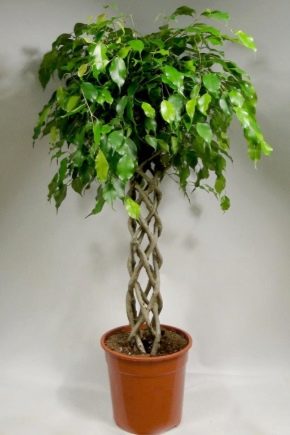
Indoor floriculture is represented by a wide variety of plants. And each indoor flower is unique and inimitable in its own way. Among this variety, Benjamin's ficus is deservedly popular; it is often used for landscaping apartments, offices and other public spaces.
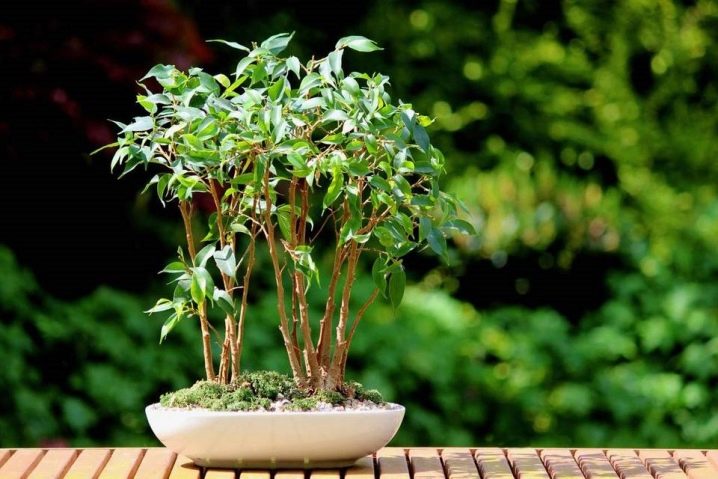
Varieties and their description
Ficus Benjamin is a representative of the genus Ficus of the Mulberry family. It grows in the countries of Asia (including the southeast) - China, India, as well as in the northern regions of Australia. It is an evergreen perennial plant (shrub or tree) with well-developed roots, it can in natural growing conditions reach a height of 25 meters.
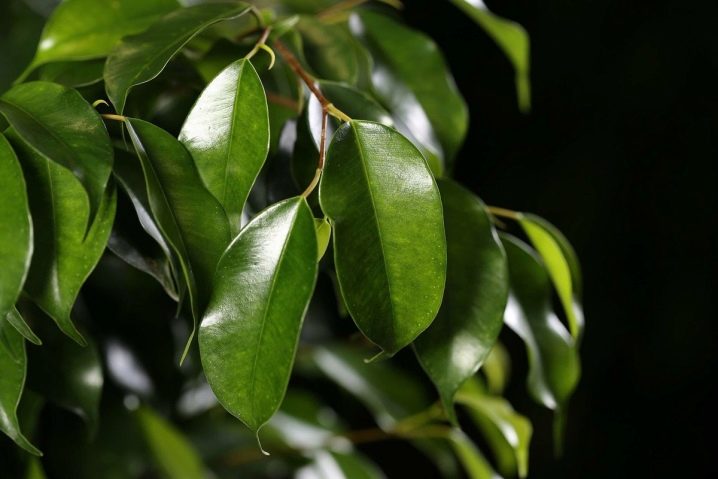
Sometimes you can find another name for it - the ficus "Balsamina", which probably arose due to the similarity of sound with "Benjamin". The species and varieties of this plant are numbered in several hundred. They all have some differences, but the general description boils down to the following.
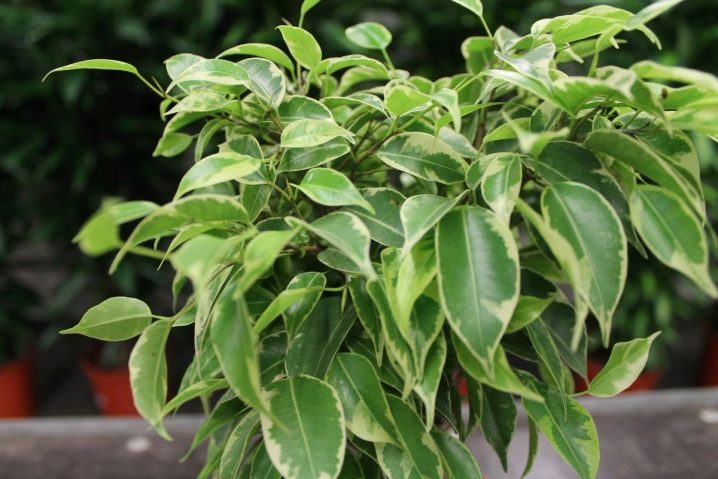
The bark at the trunk can be dark gray or light brown. The stem with many branches forms a rich lush crown. Its strong shoots are at the same time very flexible, which allows them to be intertwined in the form of a rope, pigtail or spiral. It is such a plant that can often be seen in the wild.
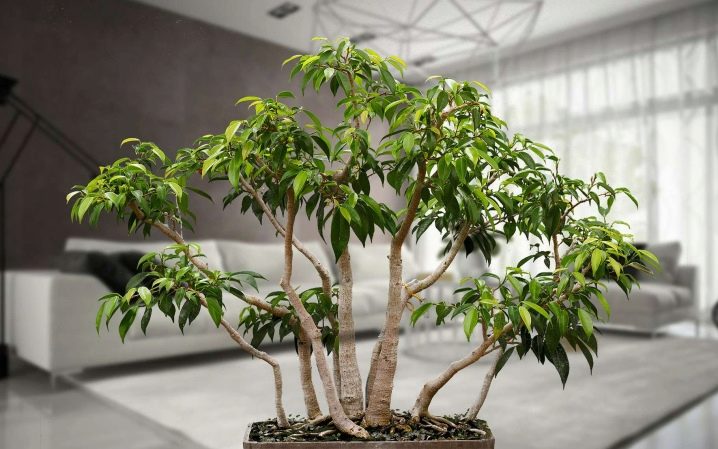
The length of the narrow (2-6 cm) fleshy leaves ranges from 5-13 cm. They have an oblong shape with a sharp tip. The color of the leaves is somewhat different in its various varieties: from dark green in the exotic variety to almost white in the Twilight variety. Its characteristic feature, like other tropical plants, is aerial roots.
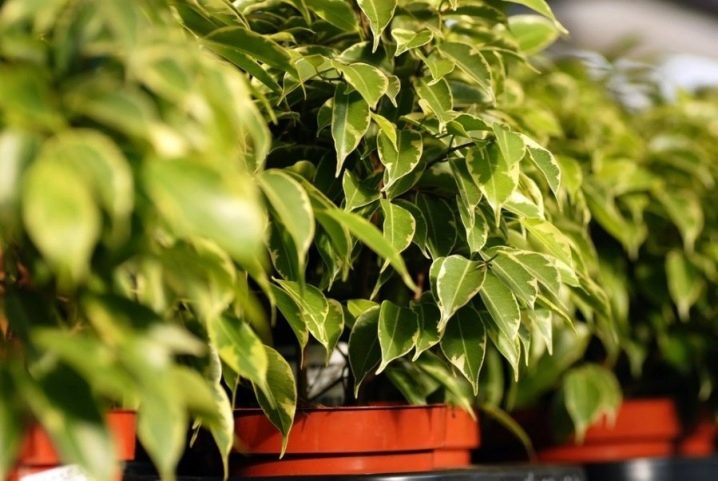
Inedible bright burgundy fruits are round and oval in shape. Flowers are white or pink in color, but flowering in indoor cultivation is very rare. This plant grows well and looks great when grown at home. It is a natural air filter, absorbing harmful elements and releasing oxygen.
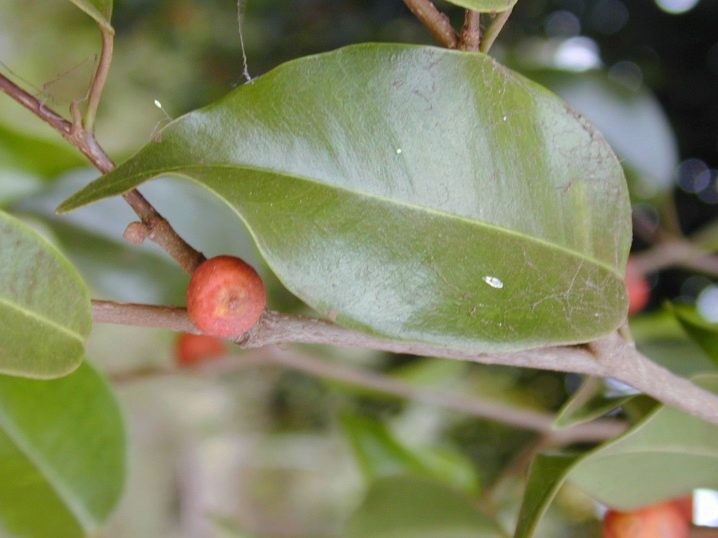
There are varieties of Benjamin ficus, differing in leaf size (large, medium and small), as well as their color. The types and structure of the trunk differ: there are ficuses with several trunks or single, tall or dwarf, as well as in the bonsai genre, the creation of which is carried out using a special growing technology. Here are the names of the most popular varieties of this ficus and their descriptions.
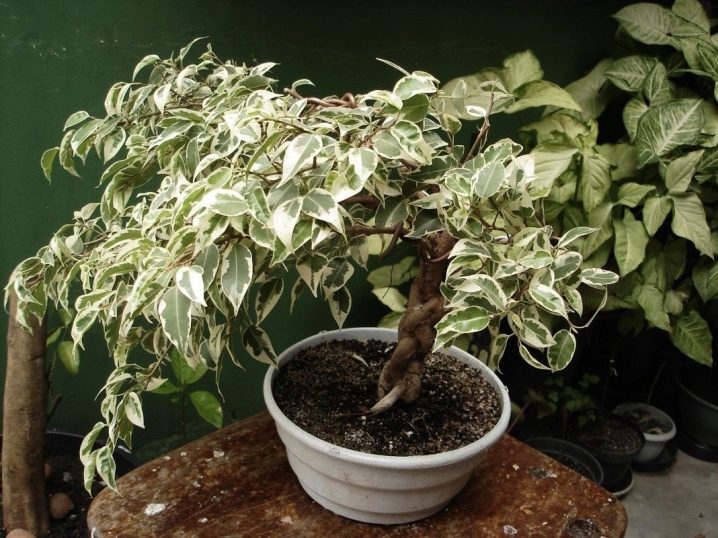
Exotic
The variety is considered one of the first varieties of Benjamin ficus to appear. "Exotic" is a fast-growing ficus, but not very large, it can reach 1.5 m and is rarely taller. The plant has small (up to 6 cm) soft leaves of bright green color with a shiny smooth surface. A distinctive characteristic is considered to be its unpretentiousness and undemandingness to lighting, even shady places are not an obstacle to its growth.

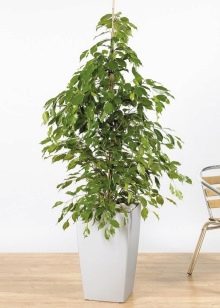
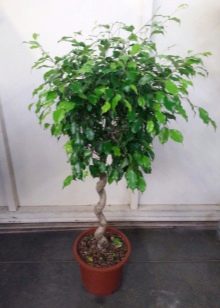
Danielle
Ficus variety "Daniella" has leaves of a rich green shade with a bright shiny surface and smooth edges. The color of the leaves changes as it grows - in a young plant, the light green shade gradually changes and becomes saturated green in an adult. The length of the leaves can reach 8 cm, the shape is oval with a pointed end.At first, the ficus has the shape of a bush with a straight-growing stem and flexible lateral shoots.
From young and flexible shoots, you can easily form a trunk in the form of a pigtail, a rope or another type. The plant is capable of growing rapidly. Differs in unpretentious care.
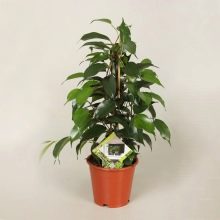
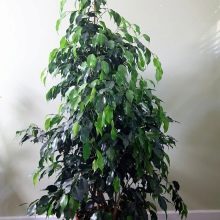
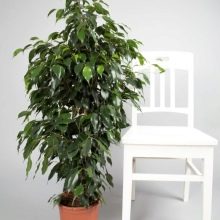
"Curly"
The variety is distinguished by its originality, which lies in the fact that its leaves are unlike each other and can have different colors (shades of white, green), as well as spots of different configurations and sizes. The shape of the leaves also differs: they can have a straight or corrugated edge, with curvatures on one side or twisting in a spiral. Curly, as it were, contains the entire variety of Benjamin's ficus leaves.
The length of the leaves is 5-7 cm, the width is 1.5-3.5 cm. The plant grows slowly, it needs the formation of a crown. "Curly" is a light-loving variety that also reacts badly to a lack of moisture.

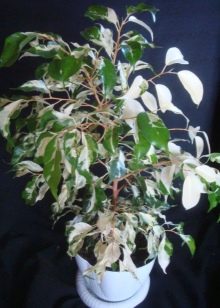
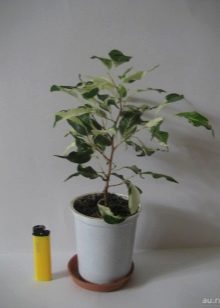
"Monique"
"Monique" is distinguished by its gracefulness, since the plant has a thin trunk, and long thin branches hang down. Large leaves with corrugated edges are colored in light green tones, like a young grass. They have an elongated, slightly concave shape. The variety is characterized by fast growth.
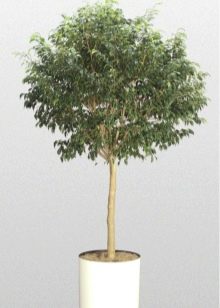
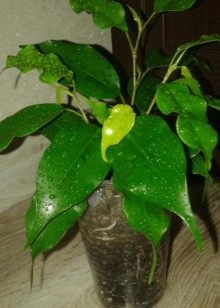
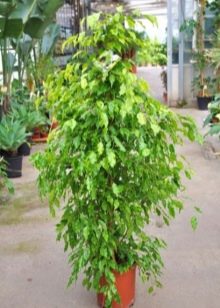
"Starlight"
"Starlight" is deservedly considered one of the most beautiful ficus honeycomb with variegated colored leaves. The variety has medium-sized leaves (4-6 cm), and the width is almost 3 times less than the length. The dark green leaves have a wide border around the entire edge, it can be so wide that almost the entire surface of the leaf is white.
The variegated leaves are slightly concave (like a boat) along the central longitudinal vein, and the sharp tip is slightly bent. The branches are flexible and capable of forming a trunk.
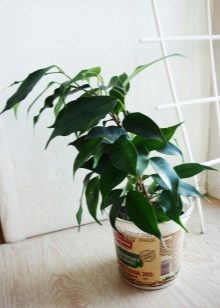
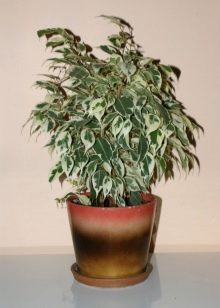
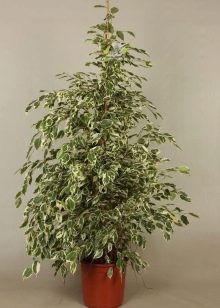
This variety is characterized by slow growth (5-7 cm per year), but longevity. "Starlight" is a plant that is demanding in terms of care and lighting conditions; if they are violated, the ficus sheds its leaves.
"Anastasia"
The variety is remembered for its succulent leaves, painted figuratively and effectively, and a dense lush crown. It is the color palette and structure of the crown that is a feature of this variety. Shiny and slightly winding leaves are quite large: about 7 cm long and up to 3 cm wide.They are painted in a rich green color, but the main longitudinal vein and an uneven (sometimes wide, sometimes narrow) border along the entire edge of the leaf have a light green tint.
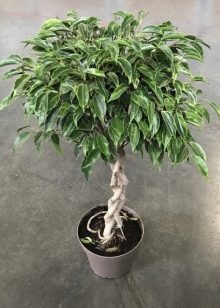

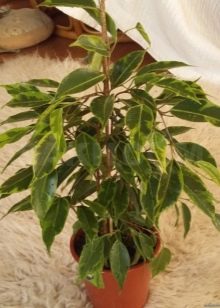
This variety can be easily formed in the form of a bush or tree, as well as create a decorative trunk shape. Ficus is fast growing and requires space and diffused lighting, good and proper care.
"Baroque"
This ficus is distinguished by its unusual curly crown, which immediately catches the eye. Small (3-4 cm) green glossy leaves have smooth but curved edges. Thanks to the curled leaves, the crown is lush and has a curly appearance.
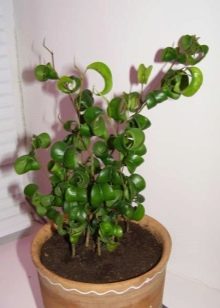
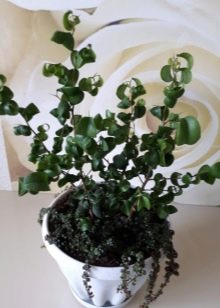
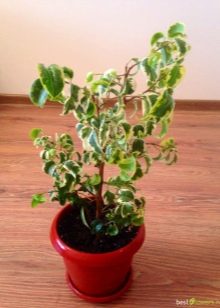
Its thin main trunk has many lateral shoots, which are just as thin and weak. Therefore "Baroque" is mainly grown in the form of a bush with several shoots in one pot. It grows slowly and does not like changing locations.
"Natasha"
In its shape, "Natasha" resembles a small tree and is considered a dwarf species, the height of which rarely exceeds 30-40 cm. The thin trunk is flexible, therefore it can be used to create different decorative shapes and is great for bonsai.
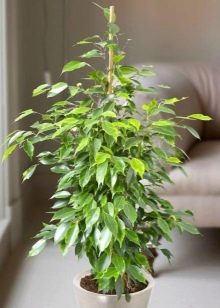

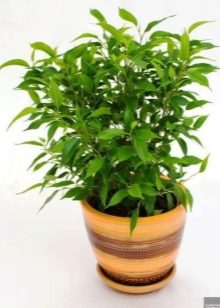
Oval leaves with a slightly bent tip are covered with a beautiful gloss. The color of the foliage can be different in shade: from dark green to light green tones. The variety is picky about care.
"Boucle"
The name itself suggests that this is one of the varieties of ficuses with a "curly" crown. It differs from the "Barok" variety by the larger size of the leaves, reaching 6 cm. The color of the oval leaves is dark green, they are wrapped inward along the main longitudinal vein. Needs regular shaping crown pruning. Ficus is characterized by whimsical care.
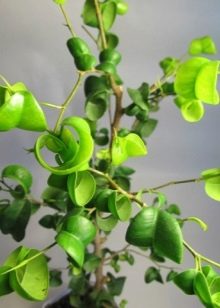
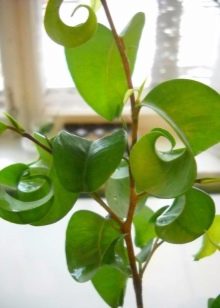
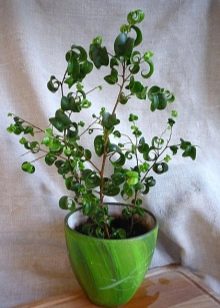
Care rules
In order for Benjamin's ficus to grow well at home, it must be well and properly looked after and certain rules must be followed.
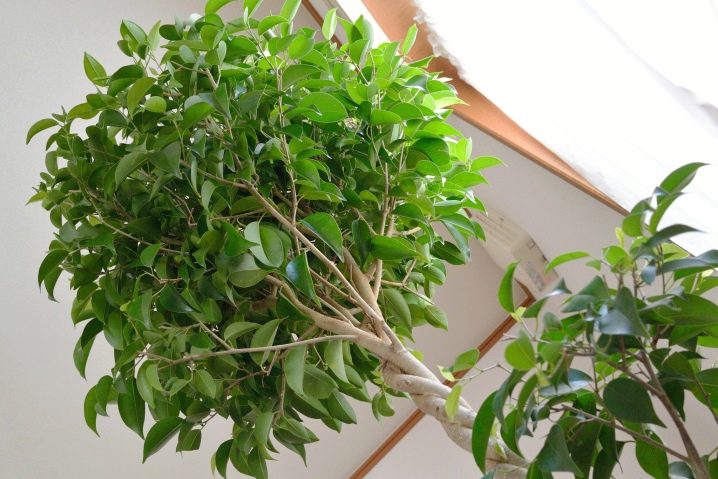
Where to place?
You need to place the flower correctly and not change its location, since he loves consistency and reacts negatively to a change of place. This is the main condition for successful growth. Since the plant requires a lot of sunlight, especially variegated ficuses, the flower should be well lit, but only with diffused light. Ficus does not tolerate direct sunlight, which can burn its leaves.
Ficus grows well on windows (or next to them), facing east or west. On the southern, sunny side, the ficus needs shading. It is not recommended to place the flower on the north side, as it will lack light.
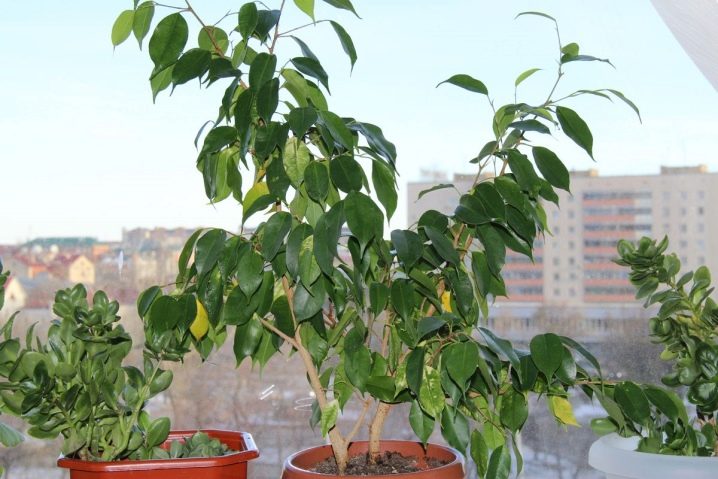
In winter, with insufficient lighting, the ficus needs additional illumination with a phytolamp. A flower growing in a corner needs such illumination all year round. In summer, it is permissible to take the flower out into the fresh air, but not very often, also protecting it from direct sunlight.
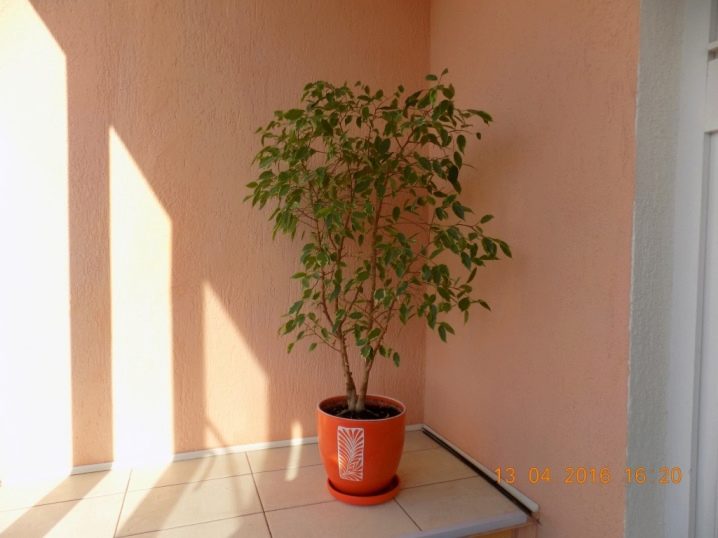
The presence of drafts, the close location of heating devices, as well as an air conditioner, is badly reflected on the well-being of the flower.
Temperature and humidity
The optimal summer temperature regime is +18 +23 degrees. In winter, an air temperature of +16 degrees is permissible, but not lower. The flower hibernates well at the usual room temperature at this time. Many varieties grow well at +16 degrees, and some (especially variegated ones) need a higher (up to +30 degrees) temperature. But all varieties react negatively by slowing growth and dropping foliage at temperatures of +15 and below. Ficus does not tolerate and temperature drops of more than 7 degrees, even if they do not lead to a violation of the permissible upper and lower limits. It is desirable that the room temperature is relatively constant.
Air humidity is also very important. Its optimal level for comfortable flower growth should be 50-70%. This moisture is created by regular water spraying of the crown. Spraying can be done daily in the summer months and less frequently in the winter.
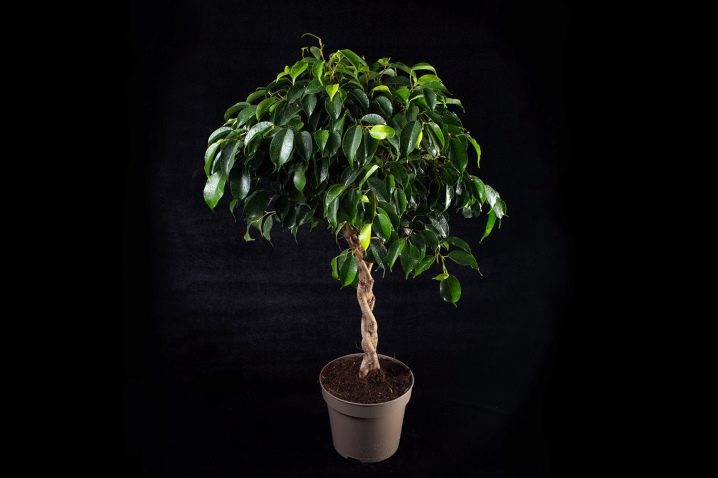
In summer, you can also enjoy water treatments 3 times a week in the shower. The water should be slightly lukewarm to keep the leaves from dropping. After the shower, the ficus must be completely dried.
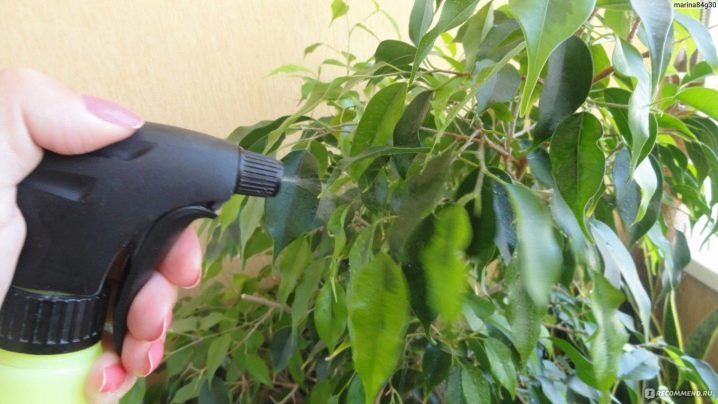
Watering
As a tropical plant, Benjamin's ficus loves moisture. The frequency and abundance of watering a flower largely depends on such conditions: temperature regime of maintenance, level of illumination, age of ficus and season. In the summer, when the plant grows intensively, the ficus especially needs watering. Watering should be done regularly (2 times a week) and should not be allowed to dry completely. In the autumn-winter period, watering is done less often - once every 7-10 days, but in sufficient quantity.
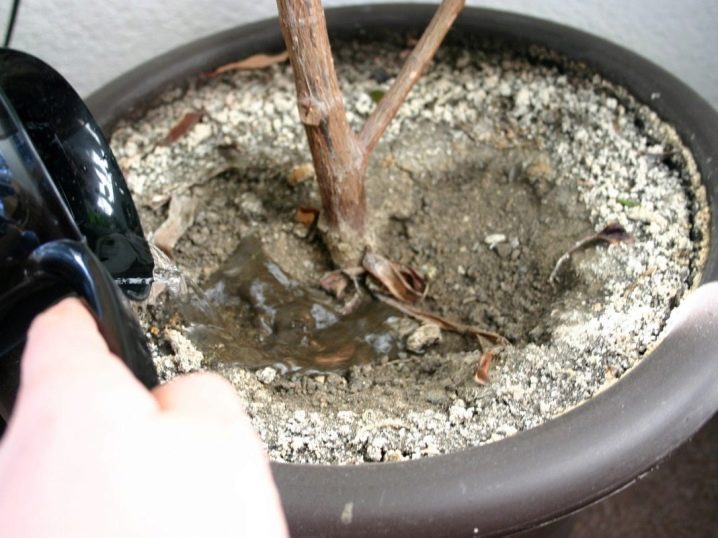
An excess of water is just as harmful as a lack of moisture, then the color of the leaves changes, and with a lack of foliage, it falls off. When watering, you should always focus on the condition of the soil. Watering can be done when the soil in the pot becomes dry to a depth of 2-3 cm. Excess water from the pan must be poured out.
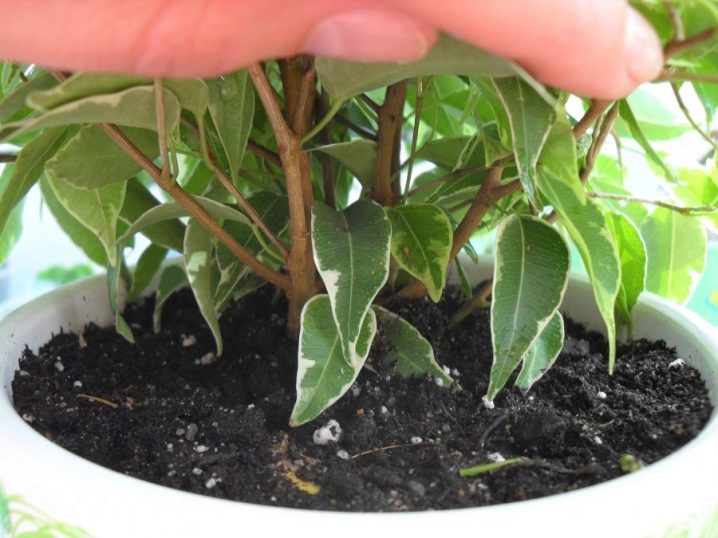
For watering, it is recommended to use settled, filtered or boiled water.
Top dressing
The growth of the plant and its development largely depend on competent feeding. After winter, during intensive growth, the root system of the ficus needs feeding. At the end of March, you can already start feeding the flower and until May, fertilizer must be applied once a month. In the period from May to the 2nd decade of June, you need to fertilize 1 time in 3 weeks, and then until October it is enough to make top dressing every 2 weeks.

From the second half of November, feeding is stopped, since the plant is temporarily dormant. For fertilization, usually chicken manure and ash are used. You can also feed it with ready-made complex fertilizers special for ficus.Most often, feeding is carried out in conjunction with watering, for this you can simply add fertilizer to the water.
Transplant and reproduction
The root system of the ficus is constantly developing and growing, the old pot becomes cramped, and roots appear in the bottom holes of the container. In this case, it is necessary to transplant the plant into a larger pot. Ficus should be transplanted in early spring. Young plants need an annual transplant for 5 years. Upon reaching this age, an adult plant is transplanted after 2-3 years. But, annually you need to remove the top layer of soil in the pot of an adult ficus and add fresh soil.
You can grow a ficus bought in a store at home only after transplanting it. But it can be carried out after 2-3 weeks: this time is necessary for the ficus to get used to the new conditions of detention. When transplanting, you can use a universal, deciduous, slightly acidic soil. You can also independently compose a soil mixture from the following components: deciduous (garden) soil - 2 parts, peat, well-rotted compost and sand - 1 part each. For an adult ficus, vermiculite, pine bark and charcoal can be added to this mixture.
A ceramic, clay pot is used for transplantation. The new container should be approximately 3 cm larger than the old one. It is not recommended to use a very large container, as this will lead to excessive development of the root system. Transplanting ficus is not difficult at all: the soil in the pot is slightly moistened - this makes it easier to remove the plant. In order not to damage the roots, the ficus must be carefully removed from the pot along with the soil clod and, without removing it, place the plant in a new pot. Usually they use the method of transferring a plant from an old pot to a new one. Then you need to fill the container with fresh soil. The transplanted ficus cannot be watered for 2-3 days, and then watered as usual.

A ficus transplant is also done in the presence of fungal or other diseases, as well as during plant reproduction. You can grow several ficus bushes by reproducing it. There are such methods for propagating ficus.
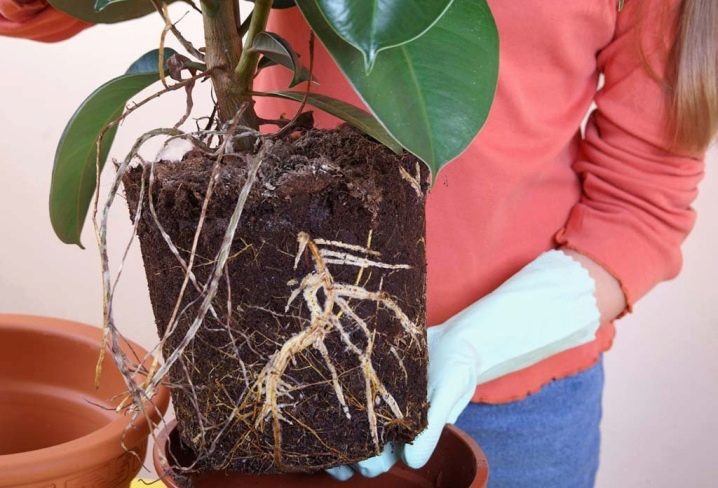
Cuttings
Ficus can be planted with a shoot - a cutting. This method is the simplest and can be carried out all year round. It is better to use woody stems for cutting cuttings. Cuttings 15-20 cm long are cut from the upper part of the stem. The largest leaves on them need to be pinched. White sap always appears in the places of the cut, which must be removed, since it slows down the growth of roots. Rinse it off under running water or hold the cuttings in warm water for about 2 hours. After removing the juice, the cuttings should be well air-dried for 2 hours. Cuttings can also be carried out in 2 ways: germination in water and in soil. Germination in water is done in this way.
- The cuttings should be placed in a container with warm water, and the leaves should not touch the water. The added 1 tablet of activated carbon will help prevent root rot.
- Cover the cuttings with polyethylene to create greenhouse conditions, which will speed up the process of root growth.
- Place the cuttings for 2-3 weeks in a place with moderate light, out of direct sunlight.
- As the water decreases, it must be added, and in case of contamination, it must be replaced with clean one.
- After the roots appear, you need to plant the cuttings in separate pots in the soil.
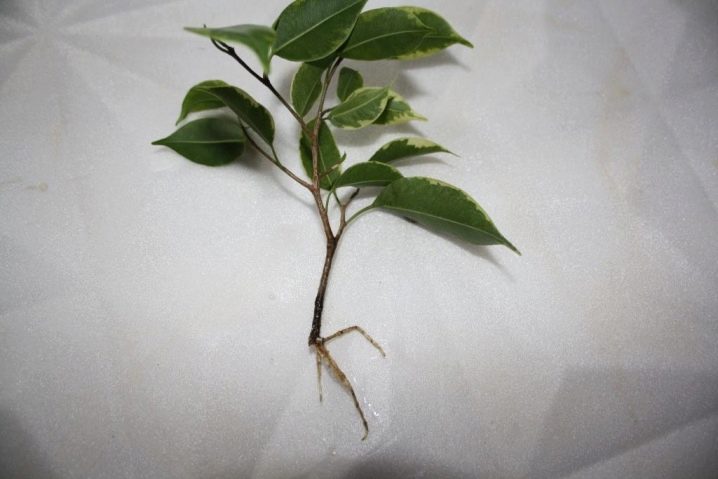
Planting cuttings in the soil is carried out as follows.
- Prepared cuttings are placed in pots with a soil mixture moistened with root growth stimulants.
- The cuttings are covered with polyethylene (you can also use cut plastic bottles or glass).
- They are kept in good lighting and at a temperature of about +25 +30 degrees. Watering and spraying cuttings is carried out if necessary, avoiding waterlogging.
- After 3-5 weeks, young shoots should grow - this means that rooting has occurred. After a while, these processes need to be transplanted into separate pots.
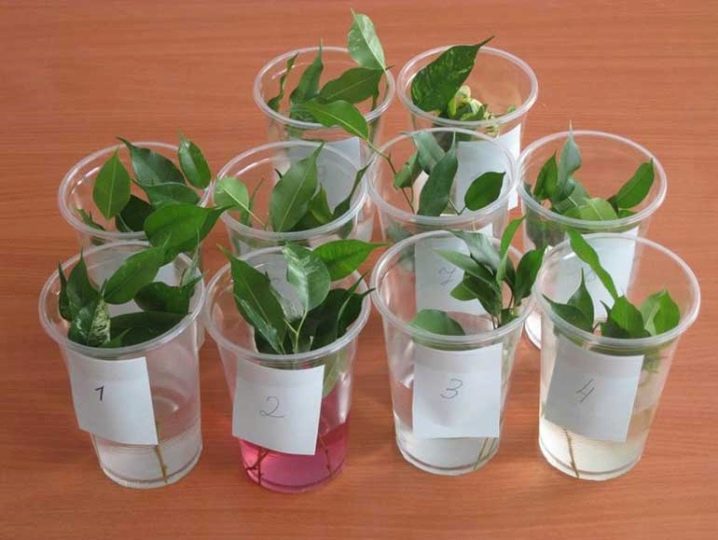
Reproduction by layering
This is a more complex method for propagating ficus. An annular incision is made on the bark of the stem. It is then covered with slightly moistened moss, and tightly wrapped with polyethylene on top, capturing sections of the stem. This will keep the moss moist. After some time (about 2 months), roots will appear in this part of the stem under the film. The stem is cut off, stepping back down from the cut, and then planted in the soil. This method is often used to rejuvenate an outdated flower.

Seed propagation
The seeds can only be purchased from specialty flower shops. First, the seeds are soaked in a growth stimulant solution for a day. This not only increases seed germination, but also increases their disease resistance. Mainly used "Epin", "Gumat", "Heteroauxin". The seeds can then be planted in a container with potting soil. Seeds are sown at intervals of 1.5 cm to a depth of 0.5 cm. Then it is worth watering the soil and covering the container with the seeds with foil.
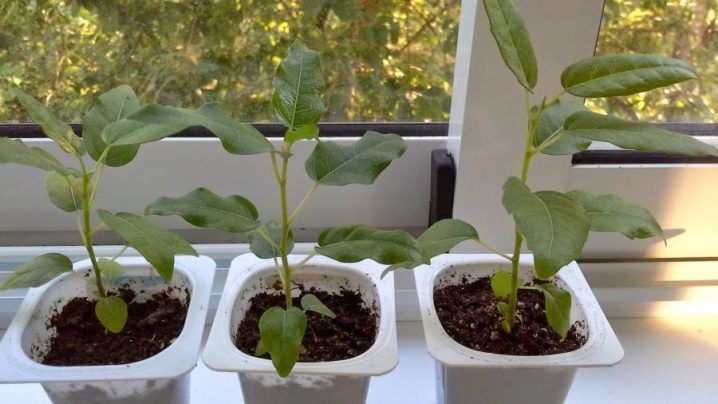
Crops should be aired daily, removing the film for 10-15 minutes. After the emergence of single shoots, the ventilation is increased to 2 hours. After the germination of most of the seeds, the film is completely removed. When the seedlings are well rooted and grow up, they are transplanted into separate containers.
Diseases and treatment
Ficus Benjamin loves attentive and caring care, non-compliance with which can lead to his illness. If the ficus grows poorly, its leaves turn yellow and fall off, it means that it is sick. Its diseases can be of fungal origin or result from damage by harmful insects. Here are the most dangerous diseases.
- Root rot. It is incurable and therefore dangerous for the ficus. Signs of root rot are the appearance of sluggish leaves, a rapid change in their color (they turn yellow), and the presence of an unpleasant odor from the soil. It is better to discard a sick flower without removing it from the pot. Observance of the correct irrigation regime will help to avoid the occurrence of this disease: it is necessary to prevent waterlogging and stagnation of water, pour water out of the sump in time.
- Gray rot - another fungal infection affecting ficus. Its symptoms are dark spots appearing on the leaves and on the stem near the roots. In a diseased plant, remove all affected leaves, parts of the plant and examine the roots. If they are defeated, it is urgently required to transplant the ficus into a new pot and replace the soil. Treatment of the plant with fungicidal agents is also effective. Improper care and excess moisture are the main causes of the disease.
- Sooty fungus. If the foliage is covered with a gray bloom, then this indicates a soot fungus infection. In case of extensive damage to the foliage, it is necessary to pluck and spray the plant with a solution of the fungicide. Single foci of sooty fungus are removed with a strong soapy solution, which is used to wipe the leaves.
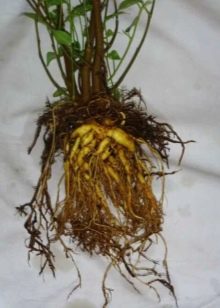
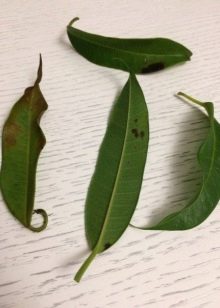
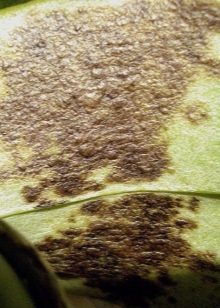
Most often, Benjamin's ficus is attacked by insects such as aphids and scale insects. The presence of aphids is indicated by yellowed leaves rolled up in a tube. The scabbard forms hard swellings of a dark brown color on the leaves. As a result, the leaves turn yellow and fall off. These insects are successfully removed with a thick soapy solution.
Thrips form small clusters on the inside of the leaf, which gradually turns yellow-white, withers and dries. You need to fight them with insecticidal agents. The mealybug feeds on ficus juice. It can be recognized by a white bloom that resembles cotton wool. If this insect appears, it is necessary to treat the flower with soap or tobacco solution. In case of severe damage, insecticides are used (for example, "Confidor").
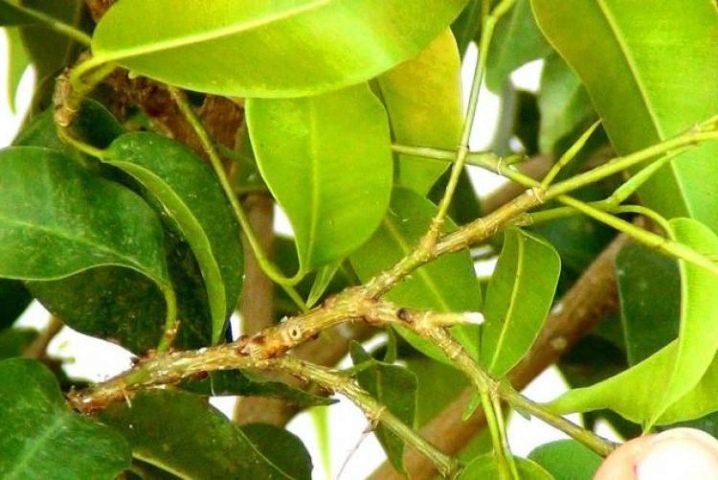
In order to prevent all these dangerous diseases, it is necessary to regularly carry out preventive examinations of the ficus and properly care for it.
You will learn more about Benjamin's ficus in the following video.































The comment was sent successfully.